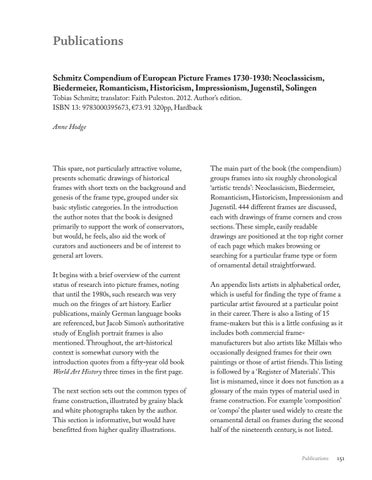Publications Schmitz Compendium of European Picture Frames 1730-1930: Neoclassicism, Biedermeier, Romanticism, Historicism, Impressionism, Jugenstil, Solingen Tobias Schmitz; translator: Faith Puleston. 2012. Author’s edition. ISBN 13: 9783000395673, €73.91 320pp, Hardback Anne Hodge
This spare, not particularly attractive volume, presents schematic drawings of historical frames with short texts on the background and genesis of the frame type, grouped under six basic stylistic categories. In the introduction the author notes that the book is designed primarily to support the work of conservators, but would, he feels, also aid the work of curators and auctioneers and be of interest to general art lovers. It begins with a brief overview of the current status of research into picture frames, noting that until the 1980s, such research was very much on the fringes of art history. Earlier publications, mainly German language books are referenced, but jacob Simon’s authoritative study of English portrait frames is also mentioned. Throughout, the art-historical context is somewhat cursory with the introduction quotes from a fifty-year old book World Art History three times in the first page. The next section sets out the common types of frame construction, illustrated by grainy black and white photographs taken by the author. This section is informative, but would have benefitted from higher quality illustrations.
The main part of the book (the compendium) groups frames into six roughly chronological ‘artistic trends’: Neoclassicism, Biedermeier, Romanticism, Historicism, Impressionism and jugenstil. 444 different frames are discussed, each with drawings of frame corners and cross sections. These simple, easily readable drawings are positioned at the top right corner of each page which makes browsing or searching for a particular frame type or form of ornamental detail straightforward. An appendix lists artists in alphabetical order, which is useful for finding the type of frame a particular artist favoured at a particular point in their career. There is also a listing of 15 frame-makers but this is a little confusing as it includes both commercial framemanufacturers but also artists like Millais who occasionally designed frames for their own paintings or those of artist friends. This listing is followed by a ‘Register of Materials’. This list is misnamed, since it does not function as a glossary of the main types of material used in frame construction. For example ‘composition’ or ‘compo’ the plaster used widely to create the ornamental detail on frames during the second half of the nineteenth century, is not listed.
Publications
151













